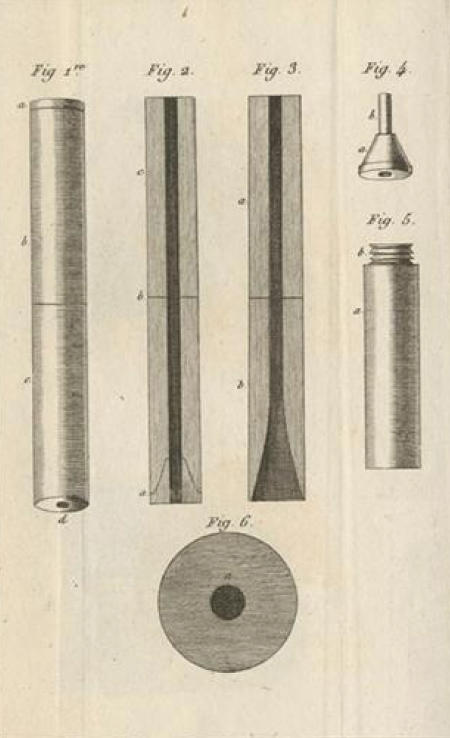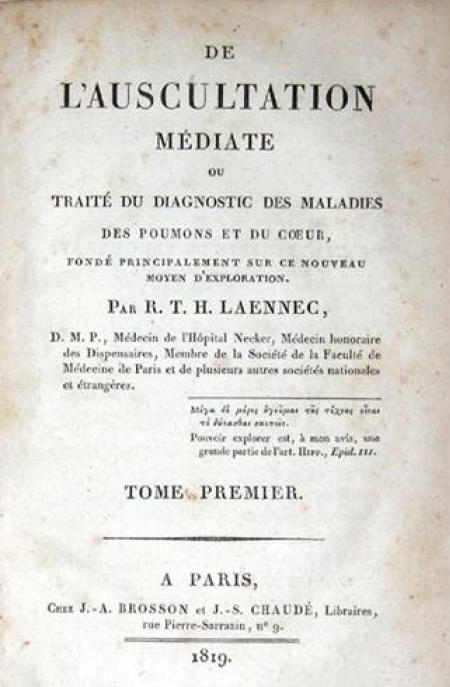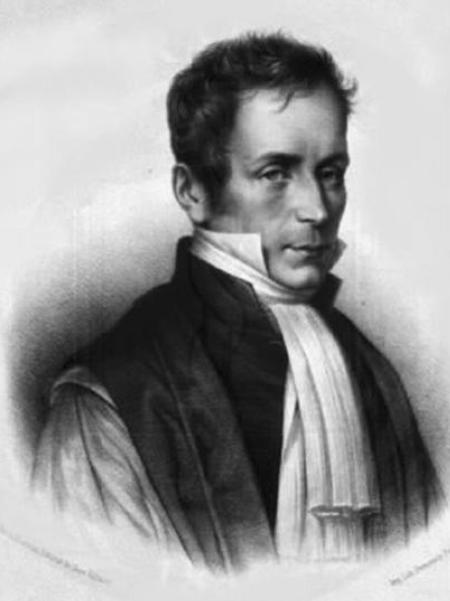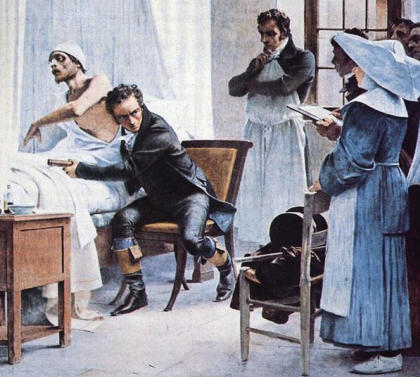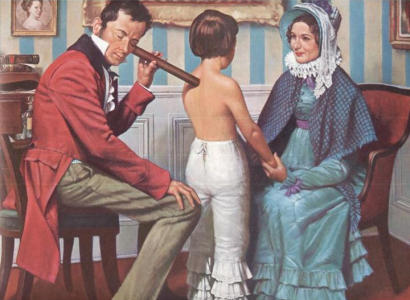Abstract
Rene Theophile Hyacinthe Laënnec (1781–1826) was a French physician who, in 1816, invented the stethoscope. Using this new instrument, he investigated the sounds made by the heart and lungs and determined that his diagnoses were supported by the observations made during autopsies. Laënnec later published the first seminal work on the use of listening to body sounds, De L’auscultation Mediate (On Mediate Auscultation). Laënnec is considered the father of clinical auscultation and wrote the first descriptions of bronchiectasis and cirrhosis and also classified pulmonary conditions such as pneumonia, bronchiectasis, pleurisy, emphysema, pneumothorax, phthisis and other lung diseases from the sounds he heard with his invention. Laënnec perfected the art of physical examination of the chest and introduced many clinical terms still used today.
Keywords: Mediate auscultation, Tuberculosis, Laënnec’s Cirrhosis, Melanoma, Ventricular systole, Atrial systole
The stethoscope may be the one instrument common to all doctors. The word stethoscope comes from the Greek words stethos, meaning chest, and skopein, meaning to explore. This instrument may even supersede the caduceus as the symbol of medicine – no other symbol so strongly identifies a doctor than a stethoscope dangling around the neck like a talisman. The story of how this remarkable invention came to be and the life of its inventor are described.
In September 1816, during a cool morning, while walking in the courtyard of the Le Louvre Palace in Paris, Dr. Rene Theophile Hyacinthe Laënnec, a 35-year-old French physician, observed two children sending signals to each other using a long piece of solid wood and a pin. With an ear to one end, the child received an amplified sound of the pin scratching the opposite end of the wood. Later that year, Laënnec was called to a young woman with “general symptoms of a diseased heart.”1,2 Both application of his hand to the chest and percussion offered little diagnostic assistance. Laënnec was reluctant to start immediate auscultation (placing the doctor’s ear on the patient’s chest) because of the age, sex and plumpness of the patient. In this moment of embarrassment, Laënnec recalled his observation of the children’s wood borne signaling. It was this observation that inspired Laënnec’s invention of the stethoscope.3 He described the invention as follows (translated from French by John Forbes, 1834):
I recalled a well known acoustic phenomenon: if you place your ear against one end of a wood beam the scratch of a pin at the other end is distinctly audible. It occurred to me that this physical property might serve a useful purpose in the case I was dealing with. I then tightly rolled a sheet of paper, one end of which I placed over the precordium (chest) and my ear to the other. I was surprised and elated to be able to hear the beating of her heart with far greater clearness than I ever had with direct application of my ear. I immediately saw that this might become an indispensable method for studying, not only the beating of the heart, but all movements able of producing sound in the chest cavity.1,4,5
Laënnec discovered that heart sounds could be heard more clearly and loudly using mediate auscultation rather than immediate auscultation. Laënnec spent the next 3 years testing various types of materials to make tubes, perfecting his design and listening to the chest findings of patients with pneumonia.5–7 After careful experimenting, Laënnec decided upon a hollow tube of wood, 3.5 cm in diameter and 25 cm long, which was the forerunner of the modern stethoscope. His instrument was fitted with a plug when used to listen to the heart and to make it portable, was made in parts that could be disassembled (figure 1 ▶).
Figure 1.
Laënnec’s stethoscope: 1) instrument assembled; 2) and 3) two portions of the instrument in longitudinal section; 4) detachable chest piece; 5) ear piece unscrewed; 6) transverse section. Photo courtesy of the US National Library of Medicine.
Laënnec investigated the sounds made by the heart and lungs with his invention and found that his diagnoses were supported by observations made in autopsies. In 1819, he published the first seminal work on the use of listening to body sounds entitled “De l’auscultation médiate ou Traité du Diagnostic des Maladies des Poumon et du Coeur”8 (figure 2 ▶) at 38 years of age.
Figure 2.
Cover of De l’Auscultation Médiate ou Traité du Diagnostic des Maladies des Poumons et du Cœur (On Mediate Auscultation or Treatise on the Diagnosis of the Diseases of the Lungs and Heart) published in Paris in 1819. Photo courtesy of Historical Collections & Services, Claude Moore Health Sciences Library, University of Virginia.
Laënnec’s wooden tube was the first true stethoscope. Wooden stethoscopes were used until the latter half of the 19th century, when rubber tubing was developed. Since the introduction of the stethoscope in 1819, several modifications have been introduced, such as the binaural, the diaphragm, and the combined bell and diaphragm (with dual or triple heads). Further developments include teaching, electronic and differential (2 chest pieces) stethoscopes. The main advancements in the evolution of the stethoscope are detailed in table 1 ▶.
Table 1.
The evolution of the stethoscope.
| Date | Inventor | Improvement |
| 1816 | Laënnec | Rolled paper cone, later a wooden tube |
| 1828 | Priorry | Funnel shaped bell, a lightened stem, and thinner earpiece for a better seal |
| 1843 | Williams | The first binaural stethoscope, using lead pipes for earpieces |
| 1851 | Marsh | Stethoscope chest piece was fitted with a flexible membrane |
| 1855 | Cammann | Binaural stethoscope with flexible tubing |
| 1894 | Bianchi | First stethoscope with a rigid diaphragm, known as a “phonendoscope” |
| 1925 | Bowles and Sprague | Combination of bell and a rigid diaphragm chest piece as used today |
| 1945–1946 | Rappaport, Sprague and Groom | Experimented with various designs to determine ideal properties for the modern binaural stethoscope – for example, a combination chest piece, short tubing with low internal volume and well fitting earpieces |
| 1956 onwards | Various (for example, Leatham, Littman, etc) | Various modern stethoscopes have been developed with improvements to weight and appearance but using the same principles described by Rappaport, Sprague and Groom |
Life and Medical Career
Rene Theophile Hyacinthe Laënnec (figure 3 ▶) was born at Quimper in Brittany, France on February 17, 1781. He was 5 years old when his mother succumbed to tuberculosis. His father, a lawyer, was unable to care for him and thus, he went to live with his grand-uncle, the Abbé Laënnec. As a child, Laënnec’s health was not good; he suffered from lassitude and occasional periods of pyrexia and was also thought to be asthmatic. He found consolation in music and spent his spare time playing the flute and writing poetry. Throughout his professional career in Paris, during exacerbations of his respiratory symptoms, he would steal to the countryside of Brittany for its rejuvenating fresh air. Laënnec was well educated in the classics and became well versed in Greek and Latin.1
Figure 3.
Portrait of Rene Theophile Hyacinthe Laënnec (1781–1826). Photo courtesy of the US National Library of Medicine.
At the age of 12 he proceeded to Nantes where his uncle, Dr. Guillaume François Laënnec (1748–1822), was Dean of the faculty of medicine at the university. Despite the turbulent times of the French Revolution, Laënnec was successful in his studies, learned English and German thoroughly and obtained a number of prizes. Laënnec was inspired by his uncle to pursue a career in medicine. In 1795, at age 14, Laënnec was already helping to care for the sick and the wounded at the Hôtel Dieu in Nantes. By the age of 18, he was serving in the Military Hospital in Nantes with the rank of third class surgeon and shortly thereafter he moved to the Hospice de la Fraternité becoming, at a young age, acquainted with clinical work, surgical dressing and treatment of patients.1
Laënnec began his medical studies in Nantes under his uncle’s direction and was appointed surgeon at the Hôtel Dieu in Nantes in June 1799 at the age of 18. In 1800, Laënnec went to Paris and entered the École Pratique in Paris studying dissection in Guillaume Dupuytren’s (1777–1835) laboratory at which macroscopic pathology in surgery and the concept of disease and its comparison with anatomical conditions were introduced. Among the terms coined there are Dupuytren’s contracture, a thickening of the palmar fascia causing the ring and little fingers to bend into the palm so that they cannot be extended; Dupuytren’s abscess, an abscess of the right iliac fossa; and Dupuytren’s bandaging, a metal splint bandaging for fixation of fractured bone in various positions. Laënnec was fortunate to also study with such famous teachers as Gaspard Laurent Bayle (1774–1816), Marie Francois Xavier Bichat (1771–1802), Jean-Jacques Leroux de Tillets (1749–1832) and Nicolas Corvisart des Marest (1755–1821), Napoleon’s life physician.
Within a year of entering École Pratique, Laënnec obtained the first prizes in both medicine and surgery at the medical school. The following year, in June 1802, he published his first paper and while still a student, published a number of papers on such notable topics as peritonitis, amenorrhea and liver disease.1 He also served as editor of the Journal de Médecine.
As his reputation increased, he began to give private instruction in morbid anatomy to supplement his income. Although suffering from asthma, he worked hard and announced his classification of anatomical lesions into encephaloid and cirrhous types. He also found that the tubercle lesion could be present in all organs of the body and was identical with that which had previously been thought to be limited to the lungs. He did not, however, realize that the condition was infectious. In 1804, Laënnec graduated in medicine with a thesis entitled, “Propositions sur la doctrine d’Hippocrate, relativement á la médecine practique.” In July 1804, he became an associate of the Société de l’École de Médecine.
Family troubles, the death of his uncle from tuberculosis, and financial difficulties coupled with his break with Dupuytren disturbed the continuity of Laënnec’s work and caused his health to fail. He recovered by going to Brittany and on his return to Paris, became an editor-shareholder of the Journal de Médecine. Although his private practice increased, Laënnec was disappointed in not being appointed as a senior physician at any of Paris’ major hospitals. On his own initiative, he founded the Athénée Médical in 1808, which later merged with the Société Académique de Paris. Soon afterward, he was appointed personal physician to Cardinal Joseph Fesch (1763–1839), the uncle of Napoleon I, however the cardinal was exiled after the fall of Napoleon in 1814. During this period, Laënnec wrote several articles on pathological anatomy.
While France was at war (1812–1813), Laënnec took charge of the wards in the Salpêtriére reserved for wounded Breton soldiers.6,7 After the monarchy’s return in 1816, Laënnec finally was offered, and gladly accepted, a position as physician at the Necker Hospital in Paris at which his most important contribution to medicine would be realized. However, owing to personal animosities, it was not until July 1822 that he was appointed to the chair and professor of medicine at the College of France. In January 1823, he became a full member of the French Academy of Medicine and professor at the medical clinic of the Charité. As a lecturer he became internationally renowned with, at times, as many as 50 doctors awaiting his arrival at the Charité Hospital. Laënnec was noted for his kindness, was beloved by his colleagues and his students, and was especially obliging towards his English-speaking students. In August 1824, he was made a chevalier of the Legion of Honor. With these honors, his private practice increased further and soon included many distinguished persons.
As might be expected from his Breton birth and training, he was intensely religious and was a devout Catholic all his life. Laënnec married Ms. Argon in 1824, just 2 years before his untimely death at the age of 45 years. He had no children; his wife had suffered a miscarriage.
Laënnec’s health deteriorated and he grew progressively weaker, though he denied that his physical condition could be due to consumption, the name popularly used to describe phthisis or tuberculosis.1 By May 1826, the fever, productive cough and shortness of breath were unrelenting and forced him to leave Paris never to return. The climate of Brittany brought a temporary improvement in his health, but he died later that year.
During those last months, he asked his nephew, Mériadec, to auscultate his chest and to describe what was heard. The auscultatory findings were as alarming as they were familiar to this great chest physician who had heard the same sounds a thousand times before. By his own invention, he could no longer escape the ironic truth that he was dying from cavitating tuberculosis – the disease that Laënnec helped to elucidate and understand with his stethoscope would soon take his life. In his will, Laënnec bequeathed to Mériadec all his scientific papers, as well as his watch and ring, and “above all, my stethoscope, which is the best part of my legacy.” Laënnec died at Kerlouanec on August 13, 1826 at the age of 45 years.
Clinical Contributions
Percussion
Prior to the development of the stethoscope, physicians had limited means at their disposal to unravel the mysteries of the chest. Leopold Auenbrugger (1722–1809),9 a Viennese physician, gave the world of medicine the invaluable tool of percussion. The son of an innkeeper, Auenbrugger had seen his father tap a barrel to see if it was empty or full. To the musically gifted Auenbrugger, the human thorax was in many ways like a wine barrel and, if tapped, would resonate. If filled with secretions, the sound would be dull and low-pitched. Auenbrugger effectively adapted this principle as a diagnostic tool for diseases of the human chest.
Laënnec was influenced by Corvisart’s teachings, which stressed bedside examination and autopsy studies. Corvisart, Napoleon’s great physician, translated Auenbrugger’s Inventum novum into French and published it in 1808 with a commentary reintroducing to medicine Auenbrugger’s neglected method of diagnosis by percussion of the chest. Laënnec followed up on the idea of his teacher, and after several years of careful study and observation, published his findings, laying the foundation for modern knowledge of diseases of the chest.
Auscultation: Immediate versus Mediate
Aside from percussion, the other option available to the early 19th century physician was the ancient practice of direct or immediate auscultation, listening to the chest sounds and heartbeat by pressing the ear to the chest wall. Immediate auscultation was known to Hippocrates and practiced in ancient Greece, but was hardly an ideal way to examine patients because some patients were too obese for sounds to be heard, or if heard, were faint and muffled making them difficult to interpret, also some patients did not bath, others were infested with vermin and modesty was an issue, especially with female patients.
Laënnec’s introduction of mediate auscultation using a stethoscope to listen for sounds of the lungs and heart (figures 4 ▶ and 5 ▶) revolutionized medicine. In 1818, Laënnec presented his findings and research on the stethoscope to the Academy of Sciences in Paris, and in 1819 he published his masterpiece, De l’auscultation médiate ou Traité du Diagnostic des Maladies des Poumon et du Coeur, 8 in two volumes (figure 2 ▶). His work was acknowledged to be a great advancement in the knowledge of chest diseases.
Figure 4.
A L’Hopital Necker, Ausculte Un Phtisique (Laënnec, at the Hopital Necker, Examining a Consumptive Patient by Auscultation). Painting by Théobald Chartran (1849–1907). Photo courtesy of the US National Library of Medicine.
Figure 5.
Laënnec and the Stethoscope. Painting by Robert A. Thom (1915–1979), c. 1960.
Later, Laënnec embarked on a revised edition of this epochal work with a masterful correlation of stethoscopic sounds and diseases of the chest documented by postmortem findings. The revised edition was published in 1826. The first English translation of De l’auscultation médiate was by John Forbes, published in London in 1821. Laënnec’s essay aroused intense interest abroad with physicians throughout Europe flocking to Paris to gain first-hand experience of this new diagnostic tool.
Laënnec’s Cirrhosis
While Laënnec’s stethoscope revolutionized diagnosis of diseases of the chest, his name is eponymously associated with micronodular cirrhosis of the liver (Laënnec’s cirrhosis).4 Although not the first to recognize this pathological entity, Laënnec gave cirrhosis its name from the Greek word “kirrhos,” referring to the tawny yellow nodules associated with this entity.
Melanoma
While still a medical student, Laënnec was the first to lecture on melanoma in 1804.10 His lecture was later published in 1806. Laënnec was the first to recognize that melanotic lesions were metastatic melanoma and not the black tuberculous granulomas or carbon deposits commonly found in the lungs at autopsy. Laënnec coined the term melanose, from Greek for black, to describe these tumors. Dupuytren took exception to Laënnec’s publication as it gave insufficient credit to Dupuytren’s work in this area. Over the ensuing years, a bitter exchange between the two took place regarding the discovery of melanoma. However, Laënnec made no mention of this dispute in his subsequent book on diseases of the chest.
Tuberculosis
Tuberculosis was common in Laënnec’s time accounting for many deaths. Laënnec himself suffered from tuberculosis and many of his family members died from the disease, including his mother, brother and uncle. His mentors, Bichat and Bayle, also succumbed to the disease.
When Laënnec was appointed physician at the Necker Hospital in Paris, it was only natural that he would focus on tuberculosis and chest diseases. But examining the chest, critical for a proper diagnosis of tuberculosis, was not easy. Laënnec became deeply absorbed in the mysteries of the chest, studying many chests and comparing his observations with postmortem findings. During autopsies he observed that the chests of tubercular patients were filled with fluid or pus and cavities. He learned to recognize pneumonia, bronchiectasis, pleurisy, emphysema, pneumothorax, phthisis and other lung diseases from the sounds he heard with his stethoscope.
Heart Sounds
In both of his books, the sections on the heart were not nearly as significant as that of the chest because so little of the physiology of the heart was understood at the time. However, Laënnec distinguished two heart sounds, attributing the first heart sound to ventricular systole and the second sound to atrial systole.
Conclusion
Laënnec was a master of clinical diagnosis and using his invention, the stethoscope, perfected the art of physical examination of the chest. Methods which are still used today. He also introduced many terms still used today and wrote two books, which were masterful descriptions of diseases of the chest and heart. He wrote the first descriptions of bronchiectasis and cirrhosis, and classified pulmonary conditions. He described murmurs and thrills, bronchial and vesicular breathing, pectoriloquy (as a sign of tubercular cavities), egophony, bronchophony, a variety of rales, and normal and abnormal lung sounds. Laennec’s distinguished career and invention of the stethoscope contributed great advances to the study and diagnosis of chest diseases.
References
- 1.Jay V. The legacy of Laënnec. Arch Pathol Lab Med 2000;124:1420–1421. [DOI] [PubMed] [Google Scholar]
- 2.Bloch H. The inventor of the stethoscope: Rene Laënnec. J Fam Pract 1993;37:191. [PubMed] [Google Scholar]
- 3.Welsby PD, Parry G, Smith D. The stethoscope: some preliminary investigations. Postgrad Med J 2003;79:695–698. [PMC free article] [PubMed] [Google Scholar]
- 4.Davies MK, Hollman A. Rene Theophile-Hyacinthe Laënnec (1781–1826) Heart 1996;76:196. [DOI] [PMC free article] [PubMed] [Google Scholar]
- 5.Clendening L. Source book of medical history. 1st ed. New York, NY: Harper & Brothers; 1942. 313–330.
- 6.Sakula A. R T H Laënnec 1781–1826 his life and work: a bicentenary appreciation. Thorax 1981;36:81–90. [DOI] [PMC free article] [PubMed] [Google Scholar]
- 7.Kligfield P. Laënnec and the discovery of mediate auscultation. Am J Med 1981;70:275–278. [DOI] [PubMed] [Google Scholar]
- 8.Laënnec RTH. De l’auscultation médiate ou Traité du Diagnostic des Maladies des Poumon et du Coeur. 1st ed. Paris: Brosson & Chaudé; 1819.
- 9.Davies MK, Hollman A. Joseph Leopold Auenbrugger (1722–1809). Heart 1997;78:102. [DOI] [PMC free article] [PubMed] [Google Scholar]
- 10.Denkler K, Johnson J. A lost piece of melanoma history. Plast Reconstr Surg 1999;104:2149–2153. [DOI] [PubMed] [Google Scholar]



